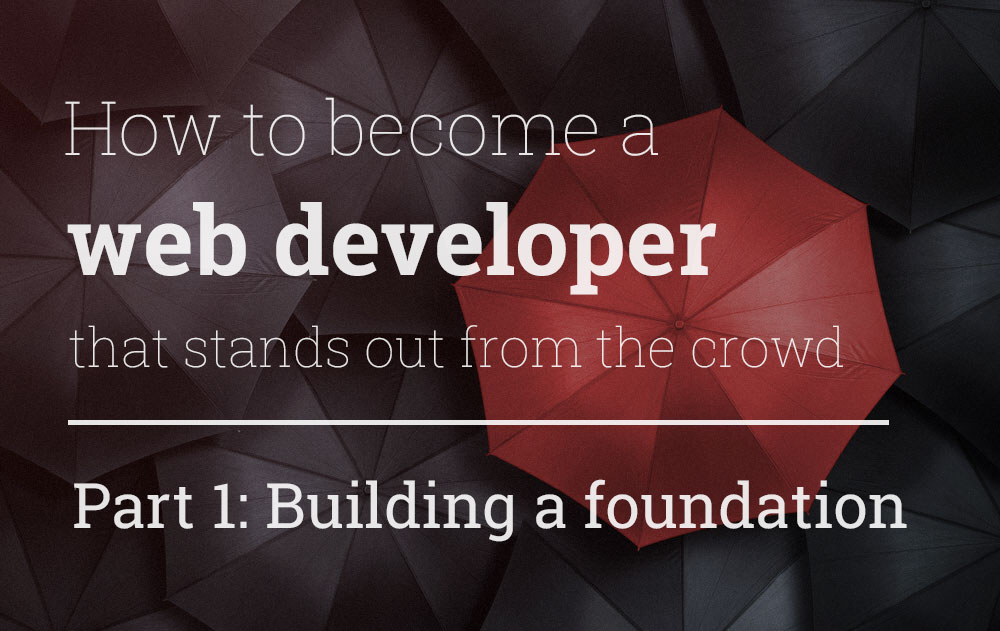
I’m not going to lie to you, to become a good web developer isn’t easy.
Knowing a little bit of HTML, JavaScript and CSS isn’t enough. I’m writing this for those of you who want to learn how to become a web developer that can hold his own with the best in the world.
While it might take some time, it is possible to teach yourself everything you need to know. If you put in the effort and focus on the right things, you will get there.
So let's get into it.
Part 1: Building a Foundation
In the first part of this series of posts, we will look at the foundations of the web and focus on the core technologies and concepts anybody who wants to become a web developer should know.
Even if you are an experienced developer, it’s worth spending a little bit of time going back to basics and making sure you have a rock solid foundation.
If you know and understand all these concepts, you should be able to build any static website. Later on, we will look at web frameworks, server side programming, data visualization and more. For now, we are focusing on the basics.
HTTP – The Transport Layer
Every single thing you do on the web is built on top of HTTP, serving web pages, REST API’s, webservices. All of these technologies use HTTP as their transport protocol.
When learning HTTP, make sure you understand:
- How the request response model works
- Headers and what they are used for
- The stateless nature of the web
- Cookies and their purpose
- The main HTTP verbs and the difference between them
- HTTPS and certificates
- Caching and all the places it could occur
Have a look at this HTTP tutorial to brush up on your HTTP knowledge.
HTML – The Content Layer
HTML is a markup language that is used to describe the content you produce on the web. HTML is combined with CSS by your browser to display information. HTML should be used to describe the content of your document and its structure. Not what it looks like. This way of thinking about HTML is called semantic HTML.
Courses and tutorials:

CSS – The Presentation Layer
Cascading style sheets are used to dress up your content. It’s a language that is used to describe to the browser how you want your HTML rendered.

Does writing CSS feel like this to you?
Because CSS seems fairly simple, it’s easy to pick up the basics by just fiddling around. Learning it this way often means you write CSS much like Peter Griffin in the image above. You try random stuff until it works or you just give up. If you have had this experience, you are not alone. Luckily, there are a few basic concepts that will allow you to actually understand what’s going on.
Concepts like:
If you are an absolute beginner at CSS, it’s worth checking out the teamtreehouse courses on CSS, I recommend the following order:
- CSS Foundations
- CSS Layout Techniques
- CSS Best Practices
JavaScript – The Programming Layer
Mastering JavaScript and learning how to be a good programmer will be your hardest task by far. If you are already a desktop or backend programmer and want to become a web developer, you have a distinct advantage.
Because learning how to program well is such a vast topic, we are only going to focus on learning the basics of the JavaScript language right now. I also have a few other posts on becoming a good programmer you might want to have a look at.
Once again, if you are an absolute beginner, have a look at the treehouse course Javascript Foundations.
Once you have a grasp of the basics, learn these techniques:
Douglas Crockford has an excellent book on JavaScript called JavaScript: The Good Parts . He also did a great series of video lectures for Yahoo that are worth watching.
. He also did a great series of video lectures for Yahoo that are worth watching.
Volume 1: The Early Years
Chapter 2: And Then There Was JavaScript
Act III: Function the Ultimate
Episode IV: The Metamorphosis of Ajax
Part 5: The End of All Things
Scene 6: Loopage
Level 7: ECMAScript 5: The New Parts
Section 8: Programming Style & Your Brain
Then get to grips with the following JavaScript Libraries:
Version Control – Looking After Your Code
Version control systems help you keep track of multiple versions of your code and allow you to undo changes as well as create different versions of your code base. There are many VCS systems but because of github GIT is by far the most popular one.
To get to grips with the basics:
Conclusion
This was is the first step in your journey to become a web developer. It’s a very important one though, spend a little extra time here and make sure you really understand the basics. It will be well worth it in the long run.
In part 2 of this series, we take a look at some new tools and techniques that will allow you to tackle more complex sites.
If you are getting stuck with anything, please leave a comment below and I’ll try and help.
Happy coding!
